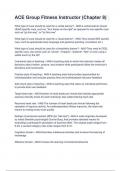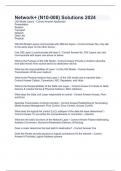BANKMANAGEMENT 2021-2022
INTRODUCTION TO BANKING
BANK BALANCE SHEET
Banks (and other financial institutions have a different asset and liability structure compared to other firms:
• Funded by financial liabilities
o Deposits
o Bonds
o Equity capital
• Assets are also mainly financial
o Cash
o Loans
o Securities
o Fixed assets
For other firms (F.E. bakery) has a lot of inventory, but their biggest assets are the fixed assets. Banks are
mainly funded by deposits and bonds (90-95%). The banks have much more leverage (debt >>> equity) than
other firms. Banks assets are also mainly financial. Their biggest assets are securities and loans (85-90%).
Assets Liabilities
Cash (5-10%) Deposits
Securities Bonds
Loans (5%) Equity capital
Fixed Assets (5%)
INCOME STATEMENT (HOW DO BANKS MAKE THEIR MONEY?)
Income is derived from:
• Lending (because loans are their main financial asset. As interest income)
• Investing in other financial assets yielding a return (non-interest income)
• Providing services (fee / commission, so non-interest income)
Expenses
• Funding costs (deposits and non-deposits liabilities. Interest expense)
• Personnel costs (non-interest expense)
• Costs of running branch network (non-interest expense)
• Etc.
Pagina 1 van 76
, Interest income (rL)
Net interest margin: rL- rD
- Interest expense (rD)
Not everybody pays back their loan, these are loan losses. = Net interest income
(=Non-Performing Loans)
+ Non-interest income
- Non-interest expense
- Provisions for loan losses
= Income before taxes
- Taxes
= Net income
FINANCIAL INSTITUTIONS AND BUSINESS MODELS
There are different types of financial institutions and business models. It depends on proportion of
business lines in income/assets.
Different types of banks:
• Retail banks: funded by deposits and gives loans. (Argenta)
• Wholesale banks: funded by bonds, and gives loans to large corporations.
• Universal banks: they do everything in the same proportion. They give mortgages or small business
loans, they give loans to large corporations, they provide type of investment banking activities.
(BNP Paribas Fortis)
WHY DO BANKS EXIST
FINANCIAL INTERMEDIATION
Allocation of resources:
• From those with surplus to those with need and productive use
• Can be done directly (via stock/bond markets). Via financial markets.
• Or indirectly via banks. Via financial intermediaries.
Pagina 2 van 76
,WHY MARKETS? WHY BANKS?
In a perfect world, without frictions, markets are the most efficient allocation mechanism. But we don’t
see this in reality. Very few people invest in stock market, why?
• Because we don’t have a perfect world/ contracts
Why do financial intermediaries exist?
• Transaction costs
• Asymmetric information
• Asset indivisibility
• Non-traded assets
• Etc.
TRANSACTION COSTS
Financial intermediaries con reduce transaction costs through:
• Expertise
o Loan officers, credit analysts. They have a lot of screening capabilities.
o Monitoring is less costly
• Economies of scale
o Offer standardized contracts / conditions
• Diversify risks
o If you want to have a diversified portfolio, you need to invest in different assets. But as an
individual you can not buy this because you don’t have enough money. The financial
intermediaries can diversify for you because of the large amount of money from different
individuals. = Asset indivisibility.
Expertise
• Type of loan: what will the money be used for?
• Income: can you make interest payments?
• Capital: how much own money will you use?
• Existing debt: have you ever defaulted? Can you make interest payments?
• Collateral: what can we recoup should you default?
Pagina 3 van 76
, ASYMMETRIC INFORMATION
One of the issues with investing is that information is asymmetric. Asymmetric information: someone has
more information than you have. Mostly, the person with more information is the entrepreneur. This is the
main reason why there are financial intermediaries.
• Ex-ante (before you make the loan)
o Will counterparty repay (good quality) or not (bad quality)
o Adverse selection
o Lemon’s problem
• Ex-post (after you make the loan)
o Will counterparty behave accordingly
o Moral hazard
ADVERSE SELECTION
Investing via stock market (direct finance) resembles “Market for lemons”. The quality is difficult to
establish beforehand.
You don’t know if you will buy a good car or not, that is the reason why you only want to pay the average
amount for a car. But sellers of the good cars will exit the market, because they have a car with a higher
value than the average amount the buyer wants to give. As a reaction all the sellers of the good car will
exit, and the average that buyers want to pay will go down. Then the market collapse.
Remedy (solutions):
• Guarantee/ certificate
• Purchase via intermediary
Information via ratings agencies:
• Certify quality of firm
• Pay to receive certification
But, free-rider problem (some people will pay for the information, but at the end it will enter the market.
So people will wait, and buy stocks or bonds with good quality firms)
• Publicly traded market will expose good and bad quality
• Who will pay for ratings
Pagina 4 van 76
INTRODUCTION TO BANKING
BANK BALANCE SHEET
Banks (and other financial institutions have a different asset and liability structure compared to other firms:
• Funded by financial liabilities
o Deposits
o Bonds
o Equity capital
• Assets are also mainly financial
o Cash
o Loans
o Securities
o Fixed assets
For other firms (F.E. bakery) has a lot of inventory, but their biggest assets are the fixed assets. Banks are
mainly funded by deposits and bonds (90-95%). The banks have much more leverage (debt >>> equity) than
other firms. Banks assets are also mainly financial. Their biggest assets are securities and loans (85-90%).
Assets Liabilities
Cash (5-10%) Deposits
Securities Bonds
Loans (5%) Equity capital
Fixed Assets (5%)
INCOME STATEMENT (HOW DO BANKS MAKE THEIR MONEY?)
Income is derived from:
• Lending (because loans are their main financial asset. As interest income)
• Investing in other financial assets yielding a return (non-interest income)
• Providing services (fee / commission, so non-interest income)
Expenses
• Funding costs (deposits and non-deposits liabilities. Interest expense)
• Personnel costs (non-interest expense)
• Costs of running branch network (non-interest expense)
• Etc.
Pagina 1 van 76
, Interest income (rL)
Net interest margin: rL- rD
- Interest expense (rD)
Not everybody pays back their loan, these are loan losses. = Net interest income
(=Non-Performing Loans)
+ Non-interest income
- Non-interest expense
- Provisions for loan losses
= Income before taxes
- Taxes
= Net income
FINANCIAL INSTITUTIONS AND BUSINESS MODELS
There are different types of financial institutions and business models. It depends on proportion of
business lines in income/assets.
Different types of banks:
• Retail banks: funded by deposits and gives loans. (Argenta)
• Wholesale banks: funded by bonds, and gives loans to large corporations.
• Universal banks: they do everything in the same proportion. They give mortgages or small business
loans, they give loans to large corporations, they provide type of investment banking activities.
(BNP Paribas Fortis)
WHY DO BANKS EXIST
FINANCIAL INTERMEDIATION
Allocation of resources:
• From those with surplus to those with need and productive use
• Can be done directly (via stock/bond markets). Via financial markets.
• Or indirectly via banks. Via financial intermediaries.
Pagina 2 van 76
,WHY MARKETS? WHY BANKS?
In a perfect world, without frictions, markets are the most efficient allocation mechanism. But we don’t
see this in reality. Very few people invest in stock market, why?
• Because we don’t have a perfect world/ contracts
Why do financial intermediaries exist?
• Transaction costs
• Asymmetric information
• Asset indivisibility
• Non-traded assets
• Etc.
TRANSACTION COSTS
Financial intermediaries con reduce transaction costs through:
• Expertise
o Loan officers, credit analysts. They have a lot of screening capabilities.
o Monitoring is less costly
• Economies of scale
o Offer standardized contracts / conditions
• Diversify risks
o If you want to have a diversified portfolio, you need to invest in different assets. But as an
individual you can not buy this because you don’t have enough money. The financial
intermediaries can diversify for you because of the large amount of money from different
individuals. = Asset indivisibility.
Expertise
• Type of loan: what will the money be used for?
• Income: can you make interest payments?
• Capital: how much own money will you use?
• Existing debt: have you ever defaulted? Can you make interest payments?
• Collateral: what can we recoup should you default?
Pagina 3 van 76
, ASYMMETRIC INFORMATION
One of the issues with investing is that information is asymmetric. Asymmetric information: someone has
more information than you have. Mostly, the person with more information is the entrepreneur. This is the
main reason why there are financial intermediaries.
• Ex-ante (before you make the loan)
o Will counterparty repay (good quality) or not (bad quality)
o Adverse selection
o Lemon’s problem
• Ex-post (after you make the loan)
o Will counterparty behave accordingly
o Moral hazard
ADVERSE SELECTION
Investing via stock market (direct finance) resembles “Market for lemons”. The quality is difficult to
establish beforehand.
You don’t know if you will buy a good car or not, that is the reason why you only want to pay the average
amount for a car. But sellers of the good cars will exit the market, because they have a car with a higher
value than the average amount the buyer wants to give. As a reaction all the sellers of the good car will
exit, and the average that buyers want to pay will go down. Then the market collapse.
Remedy (solutions):
• Guarantee/ certificate
• Purchase via intermediary
Information via ratings agencies:
• Certify quality of firm
• Pay to receive certification
But, free-rider problem (some people will pay for the information, but at the end it will enter the market.
So people will wait, and buy stocks or bonds with good quality firms)
• Publicly traded market will expose good and bad quality
• Who will pay for ratings
Pagina 4 van 76











